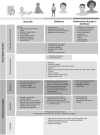The social determinants of mental health and disorder: evidence, prevention and recommendations
- PMID: 38214615
- PMCID: PMC10786006
- DOI: 10.1002/wps.21160
The social determinants of mental health and disorder: evidence, prevention and recommendations
Abstract
People exposed to more unfavourable social circumstances are more vulnerable to poor mental health over their life course, in ways that are often determined by structural factors which generate and perpetuate intergenerational cycles of disadvantage and poor health. Addressing these challenges is an imperative matter of social justice. In this paper we provide a roadmap to address the social determinants that cause mental ill health. Relying as far as possible on high-quality evidence, we first map out the literature that supports a causal link between social determinants and later mental health outcomes. Given the breadth of this topic, we focus on the most pervasive social determinants across the life course, and those that are common across major mental disorders. We draw primarily on the available evidence from the Global North, acknowledging that other global contexts will face both similar and unique sets of social determinants that will require equitable attention. Much of our evidence focuses on mental health in groups who are marginalized, and thus often exposed to a multitude of intersecting social risk factors. These groups include refugees, asylum seekers and displaced persons, as well as ethnoracial minoritized groups; lesbian, gay, bisexual, transgender and queer (LGBTQ+) groups; and those living in poverty. We then introduce a preventive framework for conceptualizing the link between social determinants and mental health and disorder, which can guide much needed primary prevention strategies capable of reducing inequalities and improving population mental health. Following this, we provide a review of the evidence concerning candidate preventive strategies to intervene on social determinants of mental health. These interventions fall broadly within the scope of universal, selected and indicated primary prevention strategies, but we also briefly review important secondary and tertiary strategies to promote recovery in those with existing mental disorders. Finally, we provide seven key recommendations, framed around social justice, which constitute a roadmap for action in research, policy and public health. Adoption of these recommendations would provide an opportunity to advance efforts to intervene on modifiable social determinants that affect population mental health.
Keywords: Mental health; marginalized groups; mental disorder; population mental health; prevention; social determinants; social justice; social risk factors.
© 2024 World Psychiatric Association.
Figures


References
-
- World Health Organization . Taking action on the social determinants of health. www.who.int/westernpacific/activities.
-
- World Health Organization . World mental health report: transforming mental health for all. Geneva: World Health Organization, 2022.
-
- Powers M, Faden RR. Social justice: the moral foundations of public health and health policy. Oxford: Oxford University Press, 2006. - PubMed
Grants and funding
LinkOut - more resources
Full Text Sources

